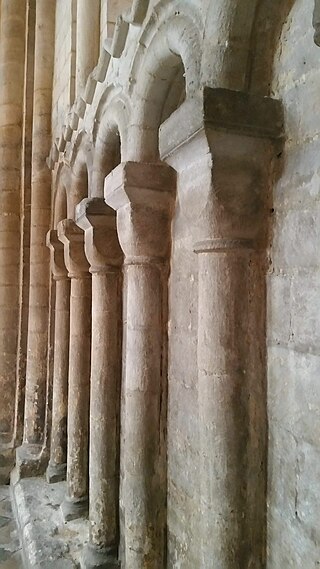
An arcade is a succession of contiguous arches, with each arch supported by a colonnade of columns or piers. Exterior arcades are designed to provide a sheltered walkway for pedestrians; they include many loggias, but here arches are not an essential element. An arcade may feature arches on both sides of the walkway. Alternatively, a blind arcade superimposes arcading against a solid wall.

The Avenue is an urban shopping plaza currently under renovation that spans three city blocks in the downtown neighborhood of Westown in Milwaukee, Wisconsin. There is one store anchored by T.J. Maxx and GRAEF-USA Incorporated, and three vacant spaces last occupied by Old Navy, OfficeMax, and Linens 'n Things.

The Eastern Market is a public market in the Capitol Hill neighborhood of Washington, D.C., housed in a 19th-century brick building. Eastern Market was listed on the National Register of Historic Places in 1971. It is located on 7th Street, S.E., a few blocks east of the U.S. Capitol between North Carolina Avenue SE and C Street SE. Badly damaged by an early-morning fire in 2007, the market building reopened in the summer of 2009 following an extensive renovation.

Quincy Market is a historic building near Faneuil Hall in downtown Boston, Massachusetts. It was constructed between 1824 and 1826 and named in honor of mayor Josiah Quincy, who organized its construction without any tax or debt. The market is a designated National Historic Landmark and a designated Boston Landmark in 1996, significant as one of the largest market complexes built in the United States in the first half of the 19th century. According to the National Park Service, some of Boston's early slave auctions took place near what is now Quincy Market.
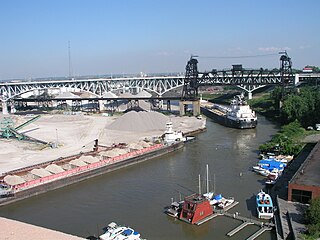
The Flats is a mixed-use industrial, recreational, entertainment, and residential area of the Cuyahoga Valley neighborhood of Cleveland, Ohio, U.S. The name reflects its low-lying topography on the banks of the Cuyahoga River.
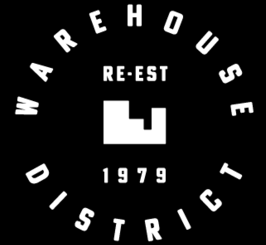
The Warehouse District is a nationally recognized historic district located in downtown Cleveland, Ohio. It is roughly bound by Front Avenue, Superior Avenue, West 3rd Street, and West 10th Street.

Reading Terminal Market is an enclosed public market located at 12th and Arch Streets in Center City Philadelphia, Pennsylvania. It opened originally in 1893 under the elevated train shed of the Reading Railroad Company after the city of Philadelphia advocated to move public markets from the streets into indoor facilities for both safety and sanitary reasons.

Downtown Cleveland is the central business district of Cleveland, Ohio, United States. The economic and cultural center of the city and the Cleveland metropolitan area, it is Cleveland's oldest district, with its Public Square laid out by city founder General Moses Cleaveland in 1796.

Ohio City is one of the oldest neighborhoods in Cleveland, Ohio. It is located immediately west of the Cuyahoga River.

The May Company Ohio was a chain of department stores that was based in Cleveland, Ohio, United States.
The Near East Side is a neighborhood located near downtown Columbus, Ohio, made up of several neighborhoods: Mount Vernon, King-Lincoln Bronzeville, Eastgate, Franklin Park, Nelson Park, Olde Towne East, and Woodland Park.

The Dayton Arcade is a collection of nine buildings in Dayton, Ohio. The Arcade is a historic, architecturally elegant complex in the heart of Dayton's central business district. Built between 1902 and 1904, it was conceived by Eugene J. Barney of the Barney & Smith Car Company and consists of nine interconnecting buildings topped by a glass-domed rotunda, 70 feet (21 m) high and 90 feet (27 m) in diameter, below which two balconied upper floors circle the central enclave. As president of the Arcade Company, Barney made sure the Arcade had the latest innovations, including elevators, a power plant and a cold-storage plant. The architect was Frank M. Andrews, known also as architect for many of NCR's factory buildings and the American Building at Third and Main Streets in Dayton.
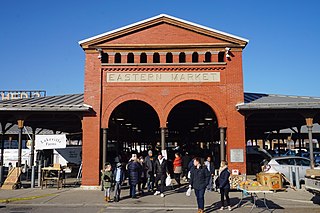
Eastern Market is a commercial district in Detroit, Michigan. It is located approximately one mile (1.6 km) northeast of the city's downtown and is bordered on the south by Gratiot Avenue, the north by Mack Avenue, the east by St. Aubin Street, and the west by Interstate 75. It is sometimes referred to as the “Little Italy” of Detroit, although the Italian community has no tight-knit ethnic neighborhood present-day. The district was designated a Michigan State Historic Site in 1974 and listed on the National Register of Historic Places in 1978; the district's boundary was increased in 2007. Eastern Market is located on the city's central east side near St. Joseph Roman Catholic Church and the Lafayette Park neighborhood. The market was transferred from city management in 2006, and now operates through a public-private partnership with the Eastern Market Corporation. Eastern Market is the largest historic public market district in the United States, and the Eastern Market farmers' distribution center is the largest open-air flowerbed market in the United States. There are more than 150 food and specialty businesses. On Saturdays, about 45,000 people shop at the city's historic Eastern Market.

Pike Place Market is a public market in Seattle, Washington, United States. It opened on August 17, 1907, and is one of the oldest continuously operated public farmers' markets in the United States. Overlooking the Elliott Bay waterfront on Puget Sound, it serves as a place of business for many small farmers, craftspeople and merchants. It is named for its central street, Pike Place, which runs northwest from Pike Street to Virginia Street on the western edge of Downtown Seattle. Pike Place Market is Seattle's most popular tourist destination and the 33rd most visited tourist attraction in the world, with more than 10 million annual visitors.

Newport Market is a traditional Victorian indoor market in Newport, South Wales. It is a Grade II-Listed building in the city centre, owned and operated by Newport City Council. The main structure, completed in 1889, is an early example of a large-span cast iron-frame building featuring a glazed barrel roof. The market re-opened in March 2022 as a multi-purpose food, retail and office space following a £5–6 million pound renovation.

Engine House No. 12 is a former fire station in the Olde Towne East neighborhood of Columbus, Ohio. Today it primarily houses Gemüt Biergarten, a German restaurant, brewery, and biergarten, with its second story used for offices. It is a contributing property to the Columbus Near East Side District, a national historic district established in 1978.

St. Lawrence Market is a major public market in Toronto, Ontario, Canada. It is located along Front Street East and Jarvis Street in the St. Lawrence neighbourhood of downtown Toronto. The public market is made up of two sites adjacent to one another west of Jarvis Street, St. Lawrence Market North, and St. Lawrence Market South. St. Lawrence Market South is situated south of Front Street East, and is bounded by The Esplanade to the south. St. Lawrence Market North is situated north of Front Street East, and is bounded by St. Lawrence Hall to the north.

The Body Block, also known as the Charles Body Block and as the Old Smith Arcade, is a historic mixed-use building located on the northwest corner of the intersection of Payne Avenue and E. 55th Street in the Goodrich–Kirtland Park neighborhood of Cleveland, Ohio, in the United States. Erected from 1892 to 1893, the Queen Anne style structure was built for Charles Body, owner of a local wallpaper store. It underwent a major renovation from 1994 to 1995, and was added to the National Register of Historic Places on September 18, 1998.

Central Market was a public market in Downtown Columbus, Ohio. The market operated from 1814 to 1966, was the location of Columbus's first city hall for two decades, from 1850 to 1872. It moved three times, each time into successively larger buildings. The third market building stood the longest time, from 1850 to 1966, when it was demolished as part of the Market-Mohawk Urban Renewal project. North Market remains, the only one left of four public markets that operated in the city.
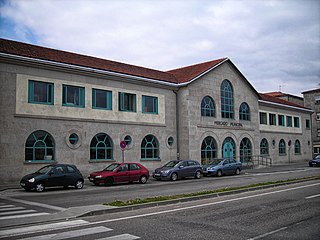
The Central Market of Pontevedra is a covered market located in Pontevedra, Spain. It is located at the north-eastern edge of the historic centre, close to the Burgo Bridge. It overlooks the banks of the Lérez river and was inaugurated in 1948.





























